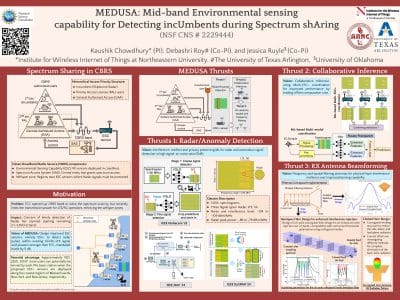Authors
Kaushik Chowdhury, Debashri Roy, and Jessica Ruyle
Abstract
Freeing up spectrum resources in the mid-band offers unprecedented opportunity to harness desirable frequencies for commercial 5G operators and for unlicensed use, although higher priority incumbents need to be reliably detected. As an example, the requirement of detecting naval ship-borne radar signals by the environmental sensing capability (ESC) sensors in the 3.55-3.7GHz Citizens Broadband Radio Service (CBRS) band severely limits the transmission power for 5G operators. Many unsolved challenges related to the timely detection of high-powered, mobile airborne and ground-radar have unfortunately stymied the opening of the remaining 3.1-3.55GHz band. The goal of this project called MEDUSA: Mid-band Environmental sensing capability for Detecting incUmbents during Spectrum shAring is to detect the presence of static/mobile radar and anomalous transmissions within concurrent and comparatively higher power 5G and 4G-LTE signals. It achieves this through machine learning (reacting to existing interference) and receiver antenna
design (proactively avoiding interference)

